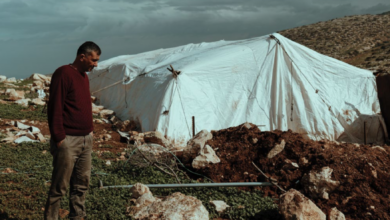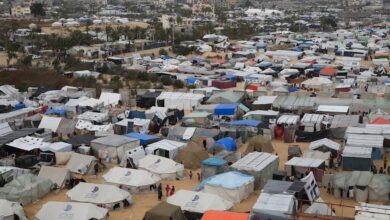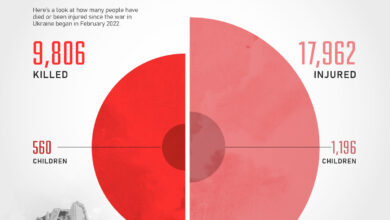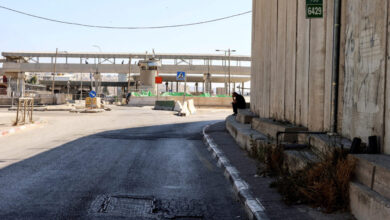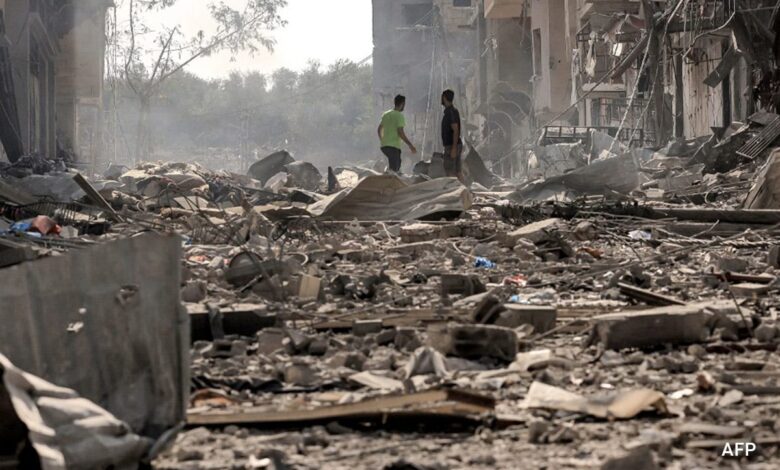
Israel Gaza EU Postwar A Complex Recovery
Israel Gaza EU Postwar: examines the multifaceted challenges and opportunities facing the region after conflict. This deep dive explores the historical context, the current humanitarian crisis in Gaza, and potential pathways toward postwar reconstruction, particularly considering the European Union’s role. From the intricate geopolitical landscape to the economic and social impact, this blog post unpacks the complexities of this critical situation.
The conflict’s history, encompassing key events and the EU’s previous involvement in peace initiatives, provides a crucial backdrop for understanding the current situation. Analyzing the EU’s current policies and positions, and their potential impact on the reconstruction process, is also vital. Ultimately, the aim is to shed light on the potential for future cooperation and lasting peace in the region.
Historical Context of the Israeli-Palestinian Conflict
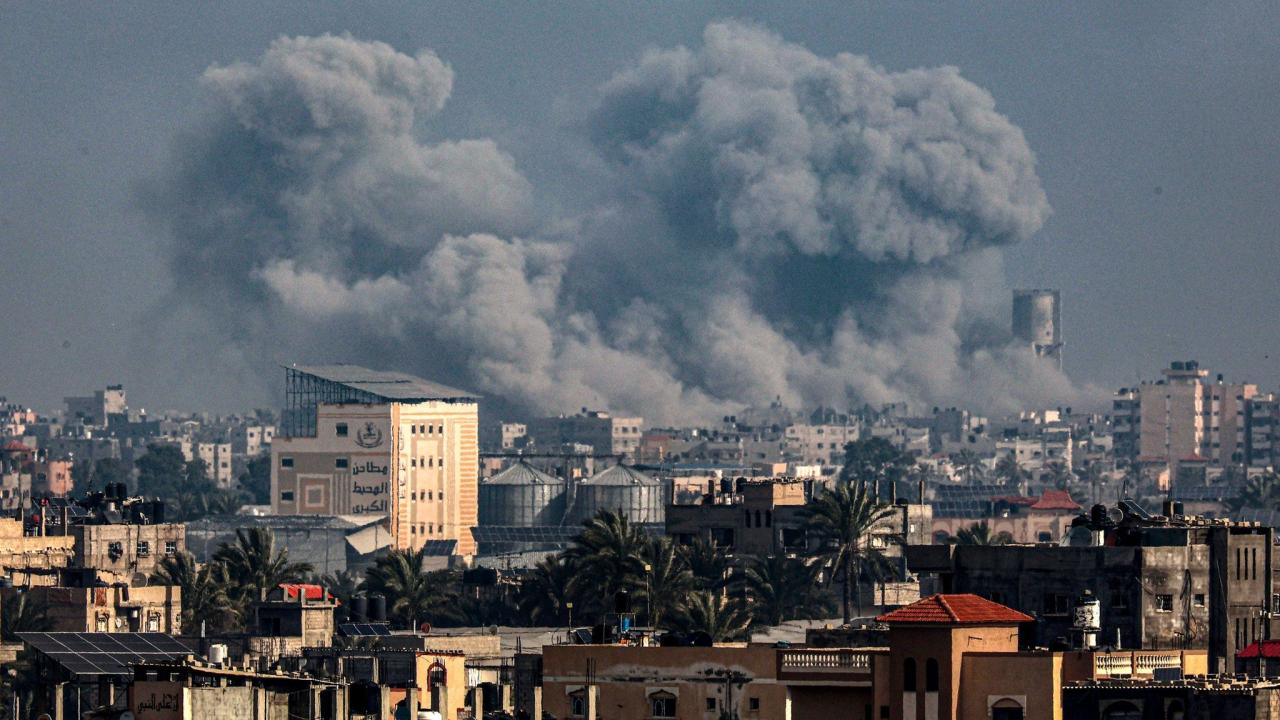
The Israeli-Palestinian conflict is a deeply rooted and complex struggle, marked by decades of violence, displacement, and competing claims to the land. Its origins lie in the historical and religious narratives surrounding the region, creating a situation where a shared past fuels the present-day conflict. Understanding this past is crucial to grasping the current situation and the ongoing challenges in achieving lasting peace.The conflict’s history is intertwined with the rise of Zionism, the Palestinian national identity, and the role of external actors.
From the Balfour Declaration to the creation of Israel in 1948, each event has had lasting consequences, shaping the attitudes and perspectives of both sides.
The Balfour Declaration and the Rise of Zionism
The Balfour Declaration of 1917, a British statement of support for a Jewish homeland in Palestine, marked a pivotal moment. It fueled Jewish immigration to Palestine, leading to increasing tensions with the existing Palestinian Arab population. The declaration, while initially intended to secure British support for a Jewish state, ultimately contributed to the complexities of the conflict.
The 1948 Arab-Israeli War and its Aftermath
The establishment of Israel in 1948 triggered the 1948 Arab-Israeli War. This war resulted in significant displacement of Palestinian populations and the creation of refugee camps. The war’s outcome shaped the demographics of the region and the historical grievances that continue to fuel the conflict.
The Six-Day War and the Occupation
The 1967 Six-Day War led to Israel’s occupation of the West Bank, Gaza Strip, and the Golan Heights. This occupation has been a significant source of contention, with Palestinians seeking self-determination and Israelis facing security concerns. The occupation’s impact on the region’s political and social landscape is substantial.
European Union’s Role in Past Conflicts and Peace Initiatives, Israel gaza eu postwar
The European Union has played a complex and evolving role in the Israeli-Palestinian conflict. Initially, support for the Jewish state and concerns about antisemitism influenced their approach. However, with growing recognition of Palestinian rights and the need for a two-state solution, the EU has gradually adopted a more balanced position. The EU has been actively involved in various peace initiatives, mediating negotiations and providing humanitarian aid to the region.
Geopolitical Landscape Surrounding the Conflict
The geopolitical landscape surrounding the Israeli-Palestinian conflict is crucial to understanding the dynamics of the region. Regional actors, including neighboring countries and international powers, have significant interests in the outcome of the conflict. Their involvement and policies influence the development and trajectory of the conflict.
Timeline of Significant Dates and Events
- 1917: The Balfour Declaration, a British statement expressing support for a Jewish homeland in Palestine.
- 1948: Establishment of Israel and the 1948 Arab-Israeli War, leading to significant displacement of Palestinian populations.
- 1967: The Six-Day War, resulting in the occupation of the West Bank, Gaza Strip, and the Golan Heights by Israel.
- 1987-1993: The First Intifada, a Palestinian uprising against Israeli occupation, leading to increased international pressure for a resolution.
- 2000-2005: The Second Intifada, another Palestinian uprising, further escalating the conflict and hindering peace efforts.
- 2006: Hamas wins Palestinian legislative elections, marking a shift in the political landscape and increasing complexities in peace negotiations.
- 2014: The Israeli military operation in Gaza, further straining the already fragile situation and causing significant humanitarian crisis.
Current Situation in Gaza: Israel Gaza Eu Postwar
Gaza, a densely populated Palestinian territory, endures a complex web of challenges. The region’s vulnerability is amplified by its protracted political stalemate, limited resources, and the ongoing impact of past conflicts. These factors intertwine to create a deeply entrenched humanitarian and human rights crisis. The continuous cycle of violence and instability has profound and lasting effects on the lives of Gazans.The recent conflicts have had a devastating impact on the civilian population.
Widespread destruction of homes, infrastructure, and essential services has created a profound humanitarian crisis. This destruction has resulted in a significant displacement of people, exacerbating existing vulnerabilities.
Human Rights and Humanitarian Crises
The human rights situation in Gaza is precarious. Restrictions on movement, freedom of expression, and access to essential services are pervasive. The lack of accountability for human rights violations further compounds the suffering. The pervasive poverty and lack of opportunity contributes to a climate of vulnerability, where individuals and communities are more susceptible to human rights abuses.
Impact of Recent Conflicts on Civilian Population
The recent conflicts have had a devastating impact on the civilian population, leading to widespread casualties, injuries, and displacement. Homes, schools, and hospitals have been targeted, leading to a breakdown of essential services. The psychological trauma experienced by survivors, including children, is immense and long-lasting. This trauma significantly impacts the mental health and well-being of the population.
The prolonged exposure to violence and insecurity creates a deep sense of fear and uncertainty.
Economic and Social Conditions
The economic conditions in Gaza are dire. High unemployment, limited economic opportunities, and a lack of access to basic necessities have created a severe humanitarian crisis. The blockade imposed on Gaza has severely hampered economic growth, leading to a decline in living standards. The limited access to basic necessities like clean water, sanitation, and healthcare is a critical concern.
Challenges Facing Humanitarian Aid Delivery
Delivering humanitarian aid to Gaza presents numerous challenges. Bureaucratic hurdles, security concerns, and political disputes often hinder the smooth flow of assistance. The ongoing conflicts and political instability create a volatile environment that jeopardizes the safety and security of aid workers. The lack of trust between parties can also limit access to affected areas, creating a vicious cycle that hinders aid delivery.
The need for coordinated efforts and consistent support from the international community is paramount.
Post-Conflict Reconstruction in Gaza
The devastation wrought by recent conflicts in Gaza necessitates a comprehensive and sustainable reconstruction effort. A robust framework must address not only the immediate needs of the population but also the underlying causes of the conflict to prevent future cycles of violence. This includes creating economic opportunities, fostering reconciliation, and ensuring long-term stability. The task is immense, demanding careful consideration of various approaches and the engagement of multiple actors.The post-conflict reconstruction of Gaza will require a multi-faceted approach, encompassing not only physical infrastructure but also social and economic development.
Success hinges on the ability to address the deep-rooted grievances that fuel the conflict, ensuring that reconstruction efforts are not merely a band-aid solution but a foundation for a lasting peace. This involves building trust, fostering reconciliation, and creating a more equitable and prosperous society for all.
Potential Framework for Post-War Reconstruction
A successful reconstruction framework must be inclusive, transparent, and address the needs of all residents. This includes establishing clear mechanisms for accountability and ensuring that decisions are made in consultation with affected communities. Furthermore, the framework should be tailored to the specific context of Gaza, considering its unique challenges and opportunities.
Roles of International Actors
International involvement is crucial for the success of any reconstruction effort. The EU, with its extensive experience in development aid and its commitment to regional stability, plays a critical role. Their involvement can leverage expertise in areas such as sustainable infrastructure development, economic diversification, and social inclusion. Other international actors, such as the UN and other donor nations, also play vital roles, contributing expertise and resources.
Collaboration among these actors is paramount to maximizing impact and ensuring effective coordination.
Financial Aid Strategies
Financial aid should be channeled effectively to maximize its impact on the ground. A key strategy is to prioritize projects that directly benefit the population, such as providing essential services, supporting small businesses, and creating job opportunities. Direct financial transfers to individuals and families can also help alleviate immediate hardship. Transparent and accountable mechanisms for disbursing aid are essential to prevent corruption and ensure that funds reach those who need them most.
The use of innovative financial instruments, such as microloans and grants, can also stimulate economic activity and foster entrepreneurship.
Infrastructure Development Strategies
Reconstruction of Gaza’s infrastructure must address critical needs while prioritizing sustainability. This involves building resilient infrastructure that can withstand future conflicts and environmental challenges. Examples include the development of water management systems, the rehabilitation of sewage and sanitation networks, and the construction of safe and accessible housing. Prioritizing renewable energy sources and environmentally conscious practices can ensure long-term sustainability.
Comparison of Reconstruction Models
Different reconstruction models have varying degrees of success in different contexts. A comparison reveals that models emphasizing community participation, local ownership, and long-term sustainability have proven more effective in fostering long-term stability and development. These models emphasize empowering local communities, fostering local capacity, and building resilience to future shocks. By integrating local expertise and perspectives into the reconstruction process, a model can better respond to the specific needs and challenges of Gaza.
EU Policies and Positions
The European Union (EU) has consistently maintained a complex and multifaceted stance on the Israeli-Palestinian conflict, navigating a delicate balance between its commitment to peace and security in the region and its strong support for the state of Israel. This position is often characterized by a nuanced approach, emphasizing diplomatic solutions and a two-state solution as the ultimate goal.
EU policy is not solely reactive but also strives to influence the situation through various means.The EU’s approach to the conflict is rooted in its broader foreign policy goals, including promoting human rights, democracy, and sustainable development. This complex framework influences the EU’s actions in the region, shaping its strategies and diplomatic efforts. The EU actively engages with both sides of the conflict, seeking to mediate disputes and foster dialogue.
EU’s Current Stance
The EU firmly supports the two-state solution, advocating for the establishment of an independent and viable Palestinian state alongside Israel. This involves a commitment to a resolution that respects the security concerns of both sides while also ensuring the protection of human rights and the well-being of all populations.
The ongoing fallout from the Israel-Gaza conflict and the EU’s postwar response is complex. While the international community grapples with the humanitarian crisis, hockey fans are likely more focused on the Oilers’ recent victory, where Stuart Skinner outplayed the Blue Jackets. oilers stuart skinner defeat blue jackets This win, however, shouldn’t overshadow the significant challenges facing the region, and the EU’s attempts to navigate the post-conflict landscape.
Key Elements of EU Foreign Policy
The EU’s foreign policy regarding the Israeli-Palestinian conflict is primarily focused on diplomacy and dialogue. It actively encourages negotiations between the Israelis and Palestinians, fostering a climate conducive to a peaceful resolution. The EU also emphasizes the importance of upholding international law and human rights standards, particularly in the context of the occupation. Furthermore, the EU recognizes the need to address the humanitarian concerns in the region and promotes sustainable development.
Past Interventions in Similar Conflicts
The EU’s experience with other conflicts, such as the Balkans or the former Yugoslavia, has provided valuable lessons. The EU has learned the importance of early intervention and the necessity of establishing international consensus. These past experiences have influenced its approach to the Israeli-Palestinian conflict, shaping its strategies for conflict resolution and peacebuilding. The EU has a history of utilizing various tools, including diplomatic pressure and economic incentives, to address conflicts and promote stability.
EU Sanctions and Trade Policies
The EU employs sanctions and trade policies as tools in its broader approach to the Israeli-Palestinian conflict. These measures are often implemented in response to specific actions or policies perceived as violating international law or human rights. The EU has a long history of using targeted sanctions and trade restrictions as a means of promoting compliance with international norms.
Such actions, however, are often accompanied by an effort to maintain humanitarian aid and avoid undue hardship on civilians. The EU’s trade policies, in general, aim to promote economic development in the region, recognizing the importance of economic stability in fostering peace.
International Relations and Diplomacy
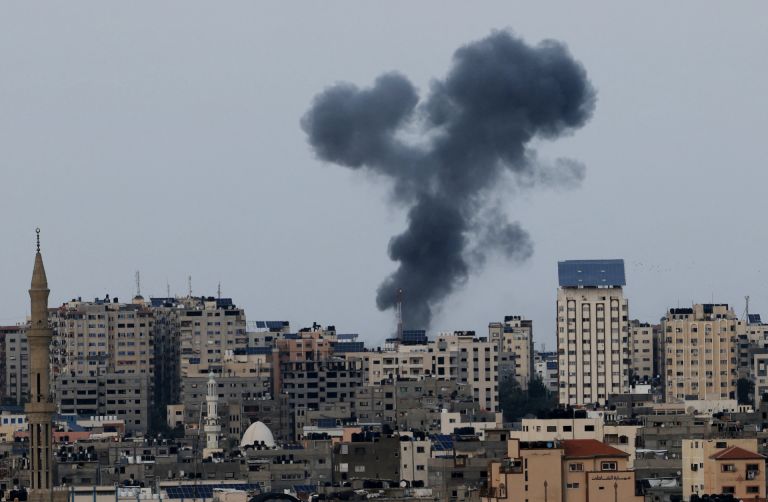
The Israeli-Palestinian conflict, a protracted and complex issue, has deeply engaged international relations and diplomacy. Numerous actors, including the EU, the UN, and regional powers, have sought to mediate, de-escalate tensions, and promote a peaceful resolution. Understanding the intricate web of relationships and the various diplomatic efforts is crucial to grasping the ongoing challenges.International efforts to address the conflict have been multifaceted and often fraught with challenges.
Different actors often have conflicting interests and priorities, which complicates achieving a unified and effective response. The ongoing cycle of violence and the lack of sustained progress highlight the need for renewed and creative diplomatic strategies.
Relationships Between Israel, Palestine, and the EU
The EU maintains a complex relationship with both Israel and Palestine. While maintaining strong ties with Israel, the EU consistently advocates for a two-state solution and condemns violence. This dual approach reflects the EU’s commitment to both security and human rights. The EU’s position is often framed by the principle of supporting the legitimate aspirations of both parties.
This involves efforts to promote dialogue and find common ground between Israel and Palestine.
Role of Other International Organizations
Numerous international organizations, including the UN and its various agencies (like UNHCR), play a crucial role in the conflict. Their responsibilities extend to humanitarian aid, refugee support, and peacekeeping efforts. The UN Security Council, in particular, has attempted to impose resolutions aimed at resolving the conflict. The UN’s involvement is often characterized by a balancing act between the needs of the different parties.
Impact of International Diplomacy
International diplomacy has had both successes and failures in shaping the Israeli-Palestinian conflict. Some diplomatic initiatives have resulted in short-term de-escalations or facilitated humanitarian aid delivery. However, sustained peace remains elusive. The failure to achieve a lasting resolution underscores the significant obstacles inherent in the conflict’s complexity. The limited success of international diplomatic efforts is often attributed to the deeply entrenched political and ideological positions of the parties involved.
Role of Regional Actors
Regional actors play a significant role in shaping the conflict’s dynamics. Neighboring countries, often with their own political and security concerns, can influence the conflict’s trajectory through their interactions with Israel and Palestine. The involvement of regional powers can either contribute to stability or further escalate tensions. Examples include mediating efforts by regional players, or the use of regional actors as tools by either side in the conflict.
The presence and involvement of regional actors add further layers of complexity to the international diplomatic efforts.
Economic Implications of the Conflict
The Israeli-Palestinian conflict casts a long shadow over the region’s economy, impacting not just the direct participants but also neighboring states and international trade. The ongoing conflict has disrupted economic activity, hindering development, and creating a cycle of instability. This analysis delves into the multifaceted economic consequences, examining the role of international trade and investment, and highlighting the challenges to recovery.The conflict’s ripple effects extend far beyond the immediate borders of Israel and Palestine.
Supply chains are disrupted, investment dries up, and the fear of further escalation discourages tourism and foreign direct investment. The political climate of uncertainty often leads to a flight of capital, exacerbating existing economic vulnerabilities.
The post-war situation in Gaza, especially with the EU’s involvement, is complex. Understanding the intricate family dynamics in the region is crucial, and this directly impacts the cultural landscape. For example, how do naming conventions like apellido bebe madre padre affect family structures and traditions? This knowledge is vital to understanding the broader implications of the Israeli-Palestinian conflict and the role of the European Union in resolving the issues.
Economic Impact on Israel
The Israeli economy, despite its relative strength, has experienced significant impacts due to the conflict. Defense spending, while creating jobs, often diverts resources from other sectors, like infrastructure and technology development. The constant threat of violence and the need for security measures place a strain on the national budget.
Economic Impact on the Palestinian Territories
The Palestinian territories, particularly Gaza, face an extremely challenging economic landscape. The blockade, coupled with the ongoing conflict, has crippled infrastructure, limited access to markets, and suppressed economic growth. Limited opportunities for employment and exports have led to widespread poverty and dependence on humanitarian aid.
International Trade and Investment
The conflict has a profound impact on international trade and investment in the region. Reduced trade volume, heightened security concerns, and political instability deter foreign investment. Companies often re-evaluate risk levels, shifting their operations to safer regions, thus reducing overall economic activity. Reduced trade and investment lead to lower incomes, job losses, and a decrease in economic growth, further perpetuating the cycle of conflict and poverty.
Comparison of Economic Situations Before and After the Conflict
| Economic Indicator | Pre-Conflict (Estimated) | Post-Conflict (Estimated) |
|---|---|---|
| GDP Growth Rate (Israel) | 3-4% | 2-3% |
| GDP Growth Rate (Palestinian Territories) | 2-3% (variable by region) | Negative (Gaza) / Low (West Bank) |
| Unemployment Rate (Israel) | 3-4% | 4-5% (or higher in specific sectors) |
| Unemployment Rate (Palestinian Territories) | 10-15% | Over 30% (Gaza) / High (West Bank) |
| Foreign Investment (Region) | Significant inflows | Substantial reduction |
Note: These are estimated values, and actual figures may vary. The table highlights the significant decline in economic indicators for the Palestinian Territories following the conflict.
Challenges to Economic Recovery
The road to economic recovery is fraught with challenges. These include:
- Security concerns: Ongoing violence and instability deter investment and hinder trade.
- Infrastructure damage: Physical damage to infrastructure in Gaza and the West Bank requires significant reconstruction.
- Blockades and trade restrictions: Restrictions on movement and trade limit access to markets and hinder economic activity.
- Lack of political stability: The lack of a resolution to the conflict creates uncertainty and discourages long-term investments.
- Brain drain: The loss of skilled workers to other countries impacts the potential for future growth.
These factors collectively create a formidable barrier to economic recovery, necessitating international cooperation and a comprehensive approach to address the root causes of the conflict.
Social and Cultural Impact
The Israeli-Palestinian conflict has profoundly shaped the social and cultural landscapes of both sides. Generations have grown up amidst the shadow of violence, displacement, and political division, impacting their identity, values, and perspectives. The conflict’s enduring nature has created deep-seated cultural differences and social barriers, making peace elusive. Understanding these impacts is crucial to envisioning a future where cooperation and reconciliation can take root.The conflict’s impact extends far beyond the immediate battlefield, profoundly affecting the daily lives of ordinary citizens.
The ongoing Israel-Gaza conflict and the EU’s postwar response are complex issues. While these weighty matters demand attention, it’s also exciting to see the fashion world celebrating milestones. For instance, the Dior Ludot 50th anniversary couture show in Paris, celebrating 50 years of exceptional design , highlights the resilience of creativity amidst global challenges. Ultimately, the EU’s role in postwar recovery and the Israel-Gaza situation remain paramount concerns.
Cultural exchange, once a source of enrichment, has been largely curtailed, further solidifying societal divisions. The struggle for self-determination and the perception of injustice have become deeply ingrained in the collective memory of both Israelis and Palestinians, fueling a cycle of mistrust and resentment.
Cultural Effects on Both Sides
The conflict has led to the development of distinct cultural narratives on both sides. For Israelis, the conflict has fostered a sense of national unity and resilience, often intertwined with a narrative of self-defense against a perceived threat. Conversely, for Palestinians, the conflict is frequently portrayed as a struggle for liberation and self-determination, marked by the loss of land and displacement.
These divergent narratives have created a profound chasm, making it difficult to find common ground.
Displacement and Refugee Crises
The conflict has resulted in significant displacement and refugee crises. Palestinians have been displaced from their homes and lands for decades, leading to a legacy of refugee communities and dispersed families. The impact on these communities is profound, affecting not only their material well-being but also their cultural and social fabric. The generational impact of displacement on families’ social structures, cultural practices, and sense of belonging is immeasurable.
Social and Cultural Barriers to Peace
Several social and cultural barriers hinder the pursuit of peace. These include:
- Deep-seated mistrust and historical grievances: The conflict has created a climate of distrust and resentment between Israelis and Palestinians, rooted in decades of conflict and perceived injustices. These deeply ingrained feelings are often transmitted across generations, making reconciliation challenging.
- Political polarization: The political landscape on both sides is often highly polarized, making it difficult to find common ground on critical issues. The political process frequently becomes entrenched in ideological positions, hindering the search for pragmatic solutions.
- Lack of trust and communication: Limited opportunities for meaningful dialogue and communication between Israelis and Palestinians have created a lack of understanding and trust. This lack of communication fuels suspicion and hinders the development of productive relationships.
- Educational disparities: The conflict has resulted in unequal access to education, with differing perspectives on history and the conflict perpetuated in the curriculum of both sides. This can exacerbate tensions and hinder understanding.
Positive Social and Cultural Developments
Despite the profound challenges, there are positive social and cultural developments that can offer hope for the future.
The ongoing Israeli-Palestinian conflict, particularly the Gaza situation, and the EU’s postwar response, are complex issues. Interestingly, the resilience of artists like Chita Rivera, whose career highlights key moments of dramatic and emotional growth, chita rivera key moments career , mirrors the enduring human spirit often found in times of political turmoil. These stories of personal triumph remind us that even amid global conflicts, individuals continue to thrive and inspire.
- Civil society initiatives: Various civil society groups on both sides are working to promote dialogue and understanding, fostering inter-communal cooperation and promoting common values. These initiatives represent valuable attempts to overcome division and promote peaceful coexistence.
- Grassroots peacebuilding efforts: Many individuals and groups are working at the grassroots level to build bridges and foster mutual understanding. These local initiatives can contribute to a broader shift in attitudes and create more fertile ground for reconciliation.
- Cultural exchange programs: Despite the challenges, some limited cultural exchange programs are taking place, allowing for interaction and fostering empathy between people from both sides. These programs offer opportunities to break down stereotypes and build relationships.
Potential for Future Cooperation
The Israeli-Palestinian conflict, a deeply rooted and complex issue, has tragically hindered the potential for regional stability and prosperity. Despite decades of negotiations and diplomatic efforts, progress has remained elusive. However, the EU, with its significant economic and political influence, can play a pivotal role in fostering a future where cooperation and peace are achievable. A renewed commitment to diplomacy, coupled with innovative approaches, is essential for addressing the multifaceted challenges and paving the way for a lasting resolution.The potential for future cooperation rests on a willingness from all parties to engage in genuine dialogue and compromise.
This requires a shift from entrenched positions to a focus on shared interests and the common good. The EU can act as a facilitator and mediator, encouraging constructive interactions and promoting mutual understanding. This will require a commitment to impartiality and fairness, ensuring that the interests of all parties are considered and respected.
Possible Avenues for Cooperation
The EU can facilitate dialogue between Israel and Palestine through various channels, including joint economic ventures, cultural exchanges, and educational programs. These initiatives can foster a deeper understanding and empathy between the two sides. The establishment of common platforms for dialogue and cooperation will help break down barriers and create opportunities for trust-building.
- Joint Economic Ventures: The EU can leverage its economic resources to encourage joint ventures between Israeli and Palestinian businesses. This can stimulate economic growth and create employment opportunities, fostering mutual dependency and interdependence, which are often key elements in de-escalating conflicts. For example, projects in renewable energy or sustainable agriculture could be implemented jointly, creating shared prosperity and encouraging a shared future.
- Cultural Exchanges and Educational Programs: Encouraging cultural exchange programs and educational initiatives can be pivotal in fostering understanding and empathy. Joint workshops, seminars, and student exchanges could help Israelis and Palestinians learn from each other’s perspectives, cultures, and histories. This approach can cultivate a more nuanced and tolerant understanding of the other side, potentially breaking down the walls of prejudice.
- Joint Infrastructure Projects: The EU could support the development of joint infrastructure projects, such as transportation links or communication networks, that would connect the two sides and promote trade and travel. This can create tangible benefits for both communities, highlighting the potential for cooperation and shared progress.
Role of Education and Cultural Exchange
Education and cultural exchange play a critical role in fostering peace and understanding. Promoting inter-cultural dialogue and cross-cultural learning can challenge preconceived notions and create a more nuanced and empathetic understanding of different perspectives. Programs that focus on shared history, values, and cultural heritage can help to build bridges between Israelis and Palestinians. For example, collaborative educational programs could offer students from both sides the opportunity to learn about each other’s history, traditions, and current challenges, fostering a shared understanding of the past and a hopeful vision for the future.
Potential Peace Agreements or Diplomatic Solutions
The pursuit of lasting peace requires innovative diplomatic solutions. A two-state solution, while a long-standing goal, may need to be adapted to address the complexities of the current situation. This may involve creative solutions that encompass the concerns of both Israelis and Palestinians, recognizing the unique challenges and needs of each community. Negotiations focusing on security, borders, and self-determination are essential to any potential peace agreement.
The ongoing postwar situation in Israel and Gaza, with the EU’s involvement, is incredibly complex. While there’s much debate about the best path forward, it’s interesting to see how the Biden administration’s stance on domestic issues, like the recent veto of the Republican’s electric vehicle charging plan, biden veto republican electric vehicle charging , might subtly influence the region’s future.
Ultimately, the geopolitical landscape in the Middle East remains a crucial focus for the international community.
Key Elements for Achieving Lasting Peace
Achieving lasting peace requires a commitment to several key elements:
- Security: Addressing the security concerns of both sides is paramount. This involves finding mutually acceptable security arrangements that ensure the safety and well-being of all citizens.
- Justice and Accountability: Ensuring justice and accountability for past actions is crucial. This can be facilitated through international mechanisms, truth commissions, or other relevant processes. Addressing grievances and injustices is essential to building trust and creating a foundation for lasting peace.
- Mutual Recognition: Mutual recognition of each other’s statehood and sovereignty is fundamental to any lasting peace agreement. This involves acknowledging the legitimate rights and aspirations of both Israelis and Palestinians. A framework for resolving disputes through peaceful means and mutual respect is paramount.
Illustrative Examples
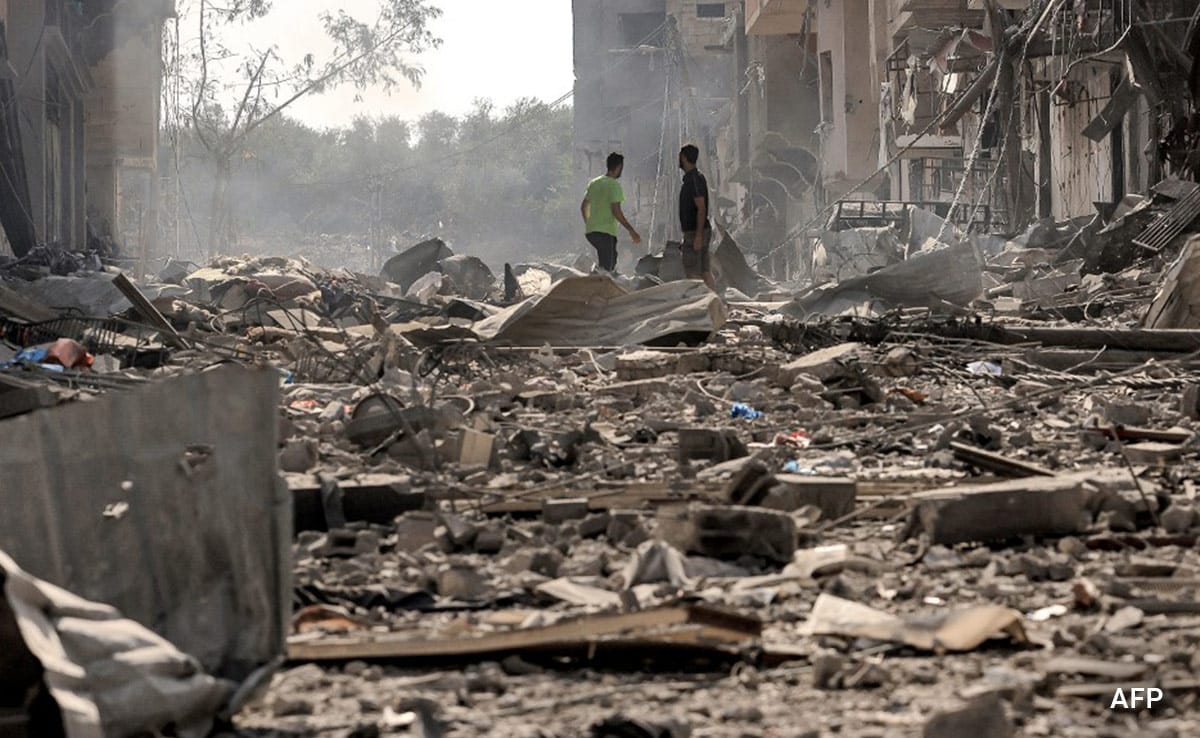
The Israeli-Palestinian conflict, particularly the situation in Gaza, presents unique challenges for postwar reconstruction and EU involvement. Analyzing past instances of conflict and EU responses offers valuable insights into potential approaches and limitations. Examining case studies of similar postwar situations, and the EU’s role, can help us understand the intricacies of this complex situation. A comparative analysis of the EU’s responses in various scenarios will highlight commonalities and differences in its approach.The EU’s engagement in conflict zones often involves a complex interplay of humanitarian aid, economic support, and political mediation.
Understanding the historical context of postwar reconstruction in the region is crucial to evaluating the potential for future cooperation and the long-term impact of the EU’s actions.
Case Study: The EU’s Response to the 2008-2009 Gaza Conflict
The 2008-2009 Gaza conflict, marked by intense violence, demonstrated the EU’s multifaceted approach to crisis response. The EU, through various organizations like the European Commission and member states, delivered humanitarian aid, including food, medical supplies, and shelter materials. Simultaneously, the EU actively sought to facilitate a political resolution to the conflict, encouraging dialogue and supporting international efforts to achieve a ceasefire.
However, the EU’s response was hampered by the political divisions and security concerns in the region. The EU’s efforts to support the reconstruction of Gaza’s infrastructure and economy were also limited by the ongoing political tensions and the blockade imposed on the territory.
Comparison of EU Responses in Post-Conflict Scenarios
| Conflict | Year | EU Response (Focus Areas) | Successes | Challenges |
|---|---|---|---|---|
| Bosnian War | 1990s | Humanitarian aid, peacekeeping forces, economic support, political mediation | Significant improvement in humanitarian conditions, stabilization of the region | Political divisions, long-term security concerns |
| Gaza Conflict (2008-2009) | 2008-2009 | Humanitarian aid, political mediation, reconstruction efforts | Provision of vital aid, limited political engagement | Ongoing political tensions, blockade, security issues |
| 2014 Gaza Conflict | 2014 | Humanitarian aid, political pressure, limited reconstruction support | Aid distribution, efforts to foster peace | Political deadlock, limited influence on actors involved |
Historical Example: Post-World War II Reconstruction in Europe
The post-World War II reconstruction of Europe provides a valuable historical example of the challenges and opportunities involved in rebuilding a region devastated by conflict. The Marshall Plan, spearheaded by the United States and supported by other Western nations, played a critical role in the economic recovery of Europe. The plan provided financial aid to rebuild infrastructure, support industries, and stimulate economic growth.
The EU, in its own way, has drawn upon the lessons from the post-World War II experience to address postwar situations, albeit with specific nuances relevant to its own political and economic context. This historical example illustrates the importance of international cooperation, economic support, and political will in fostering long-term stability and recovery.
Final Summary
In conclusion, the Israel-Gaza-EU postwar scenario presents a formidable challenge demanding multifaceted approaches. The intricate interplay of historical context, current realities, and potential future cooperation requires careful consideration of the geopolitical landscape, economic implications, and the social and cultural impact. The EU’s role in this complex situation is pivotal, and a comprehensive understanding of its policies and past interventions is crucial for any discussion on possible paths forward.
Ultimately, achieving lasting peace and reconstruction in the region requires collaborative efforts from all stakeholders.
FAQ Overview
What are the specific economic challenges faced by Gaza after the conflict?
Gaza’s economy is crippled by years of conflict and blockade. Reconstruction efforts face hurdles like limited access to resources, destroyed infrastructure, and a shortage of skilled labor. The lack of international trade further compounds the economic downturn.
What role do other international organizations play in the postwar reconstruction of Gaza?
Numerous international organizations, including the UN and various humanitarian aid groups, are actively involved in providing aid and support. They often work in conjunction with the EU, focusing on humanitarian relief and rebuilding essential services.
What are some potential obstacles to future cooperation between Israel, Palestine, and the EU?
Deep-seated mistrust and political disagreements between the parties, historical grievances, and the ongoing conflict can significantly hinder future cooperation. Securing trust and establishing a shared vision for peace will be crucial.


